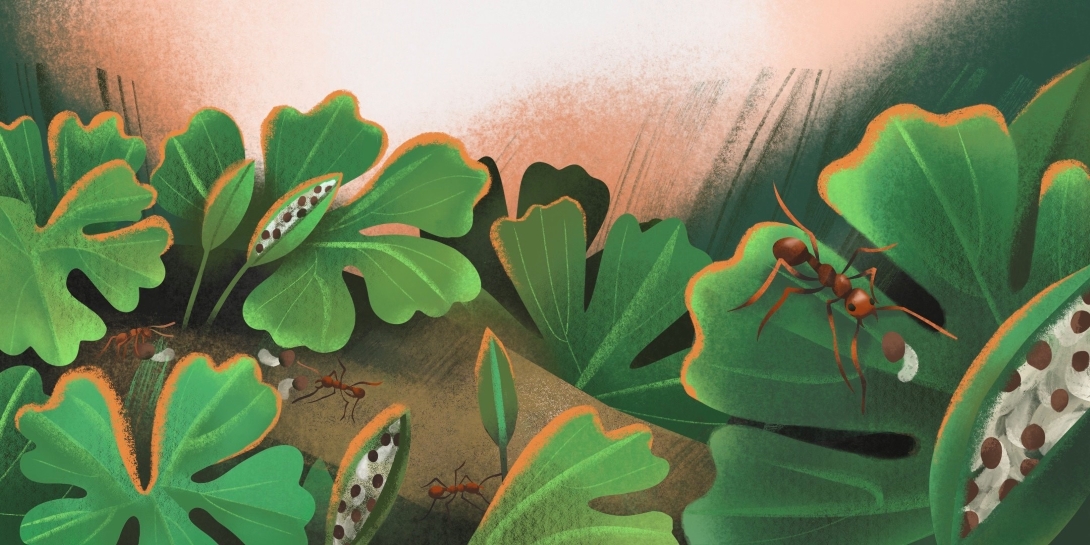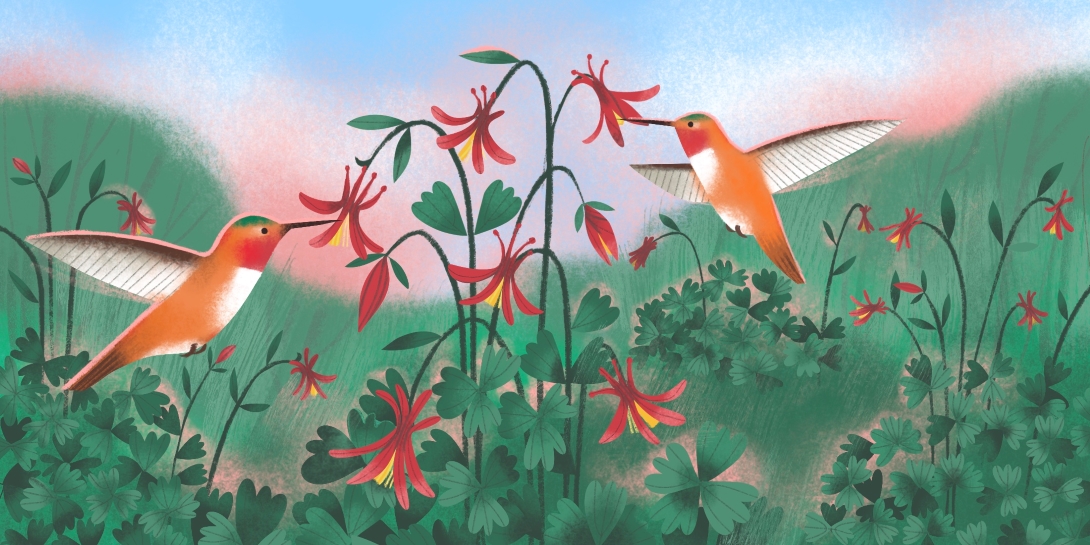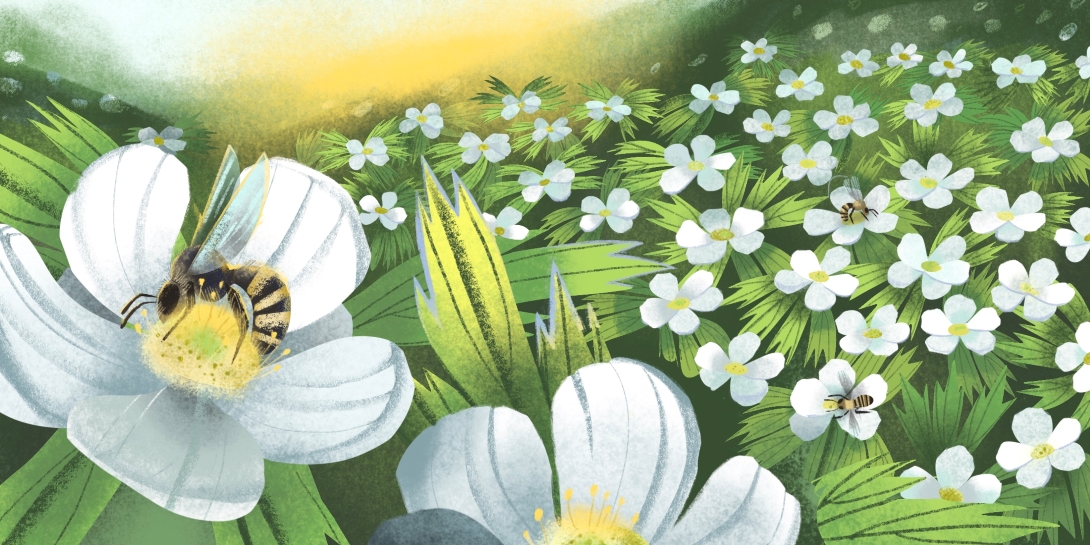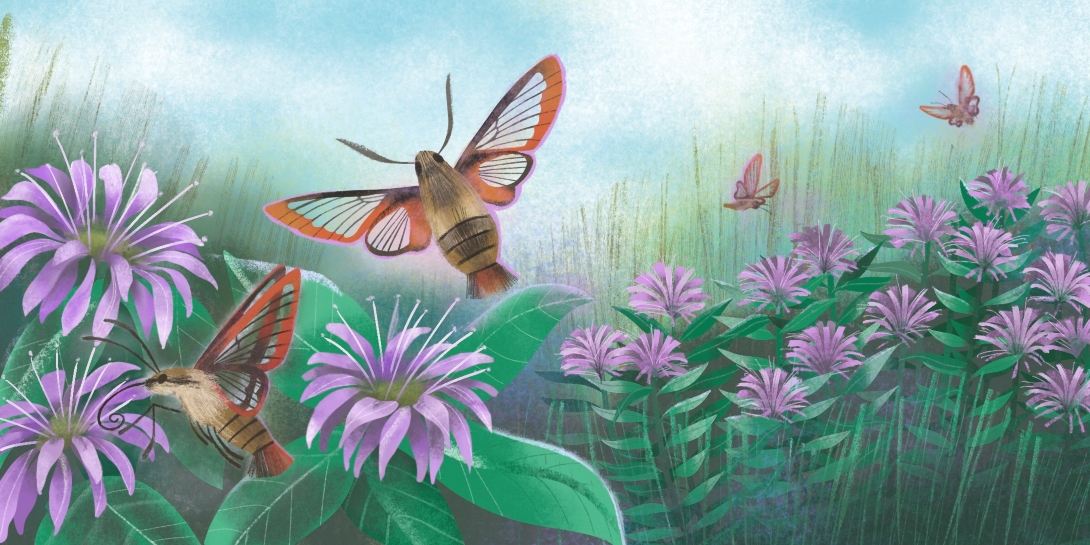Spring flowers are for the birds and the bees… and the ants?
By Jarmila Becka Lee, Steve Hamel and Ellen Jakubowski
What’s more uplifting than seeing the first flowers of spring after weeks of dingy mud and snow? As the weather warms and the season progresses, different colours paint our landscapes, adding a kaleidoscope of brightness to our days.
Flowering plants may satisfy our human yearning for beauty, but other species have more practical reasons for paying attention to them. From a moth in disguise eager for an energy drink to an army of ants looking for greasy takeout, a range of wildlife depend on native plants to keep them fed.
Read on to discover wildlife you may encounter this spring.
Bloodroot + ants

Bloodroot (Sanguinaria canadensis) is an early spring ephemeral, meaning that its leaves and flowers are visible for a short time in early spring before disappearing for the rest of the year. Its single bright-white flower blooms before the large, lobed leaves unfurl. Once it’s been pollinated either by bees and flies or by itself (a bloodroot plant’s pollen-bearing male parts eventually come into contact with its female parts, which will result in self-pollination if pollinators haven’t already done the job), it develops an elongated seed pod.
Each seed in the pod has a fleshy appendage called an elaiosome. Once seeds mature and the seed pod splits, ants belonging to the genus Aphaenogaster are attracted to the fatty, nutrient-rich elaiosomes. The ants carry the seeds to their nest, where they feed the elaiosomes to their young. Then, they discard the seeds in or near the nest, in effect planting them. The refuse pile where they put the seeds contains nutrient-rich organic material: just what the seeds need to germinate.
In Canada, keep an eye out for bloodroot and its insect associates from southeastern Manitoba to Nova Scotia.
Western columbine + rufous hummingbird

The whimsical-looking western columbine (Aquilegia formosa) is commonly found in moist spots within wooded areas and alpine and subalpine meadows. Its distinctive nodding red and yellow blooms attract wildlife species such as butterflies and rufous hummingbirds (Selasphorus rufus). These hummingbirds visit the western columbine, one of their preferred nectar sources, from late spring to early summer. The plant’s tubular flowers are the perfect shape for their long beaks and flicking tongues to fit into to get at the nectar.
You can spot this columbine, and the hummingbirds that frequent it, in Alberta, BC and Yukon.
Canada anemone + sweat bees

Canada anemone (Anemonastrum canadense) has attractive, long-lasting white flowers, and it spreads easily — even through lawn — making it a great ground cover. The pollen provided by Canada anemone is an important food source for many native bees in late spring and early summer, including small Andrenid (miner) bees and Halictid (sweat) bees. Other pollinators it attracts include Syrphid flies (also known as hover flies or flower flies).
Canada anemone has a wide distribution in Canada, stretching from B.C. in the west to Newfoundland in the east, and in the warmest months can sometimes even be spotted as far north as Northwest Territories.
Wild bergamot + hummingbird clearwing moth

The hummingbird clearwing moth (Hemaris thysbe) is a spectacular moth that looks and behaves like a hummingbird as it flies around by day, sipping nectar from prairie and meadow plants like wild bergamot (Monarda fistulosa).
In addition to this moth, wild bergamot flowers draw butterflies, bee flies (fuzzy flies that look like bees), wasps and a host of bee species, including bumble bees, miner bees, epoline cuckoo bees, large leaf-cutting bees and sweat bees. A small black sweat bee called Dufourea monardae appears to feed only from wild bergamot and other flowers in the same genus, Monarda. Sweat bees both pollinate and drink nectar while visiting wild bergamot, whereas some wasps “steal” its nectar by making a hole in the nectar tube so they can drink without pollinating the plant.
In Canada, you can find wild bergamot and its many winged visitors from B.C. all the way to Quebec.
Curious to know which wildlife species visit native plants in other seasons? Check out our fall flowers post.
To give these wildlife species and others a helping hand — and to observe them close to home — try planting native plants in your yard, on your balcony or at a nearby community space. Visit wwf.ca/regrow to learn more.


